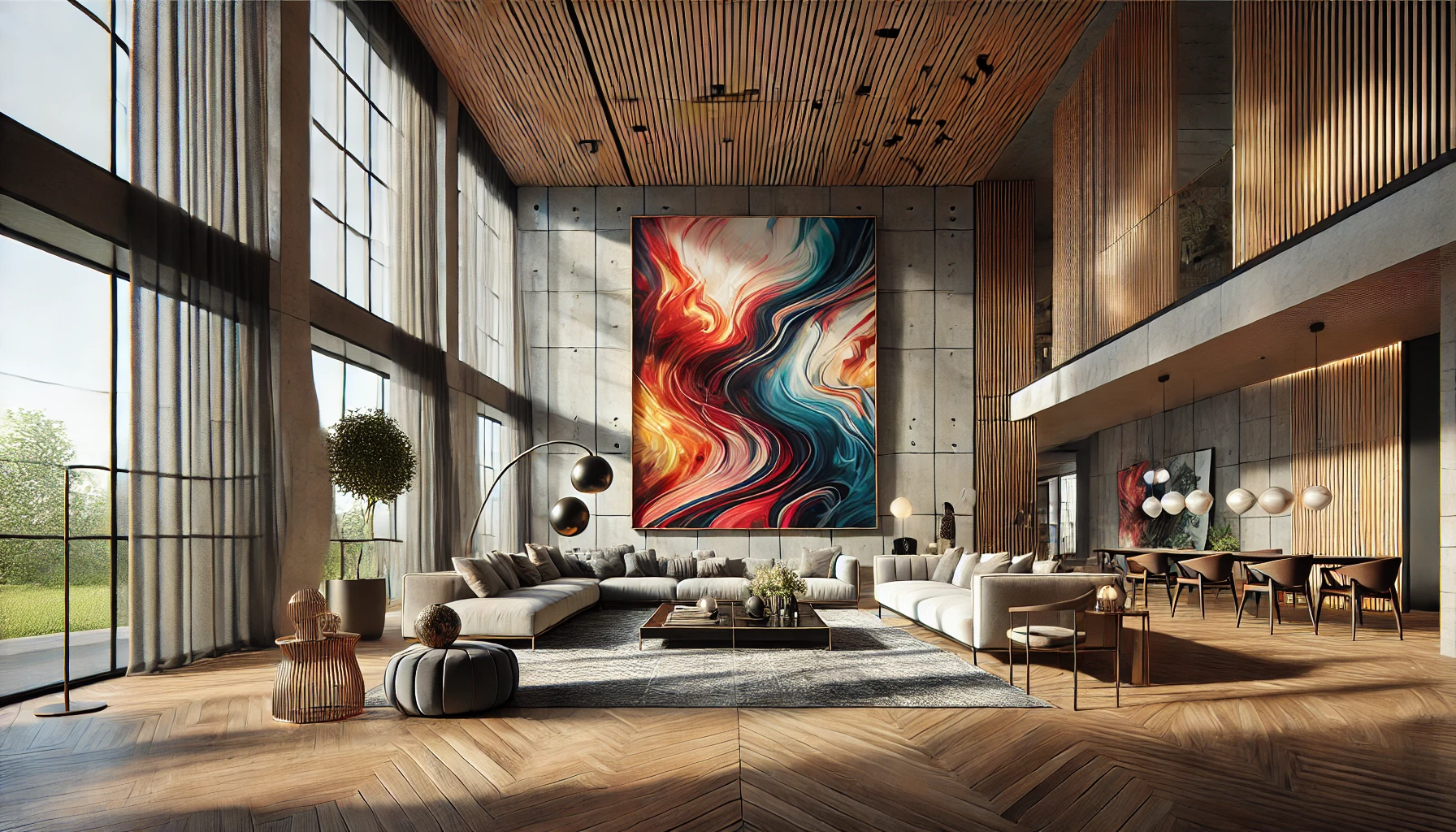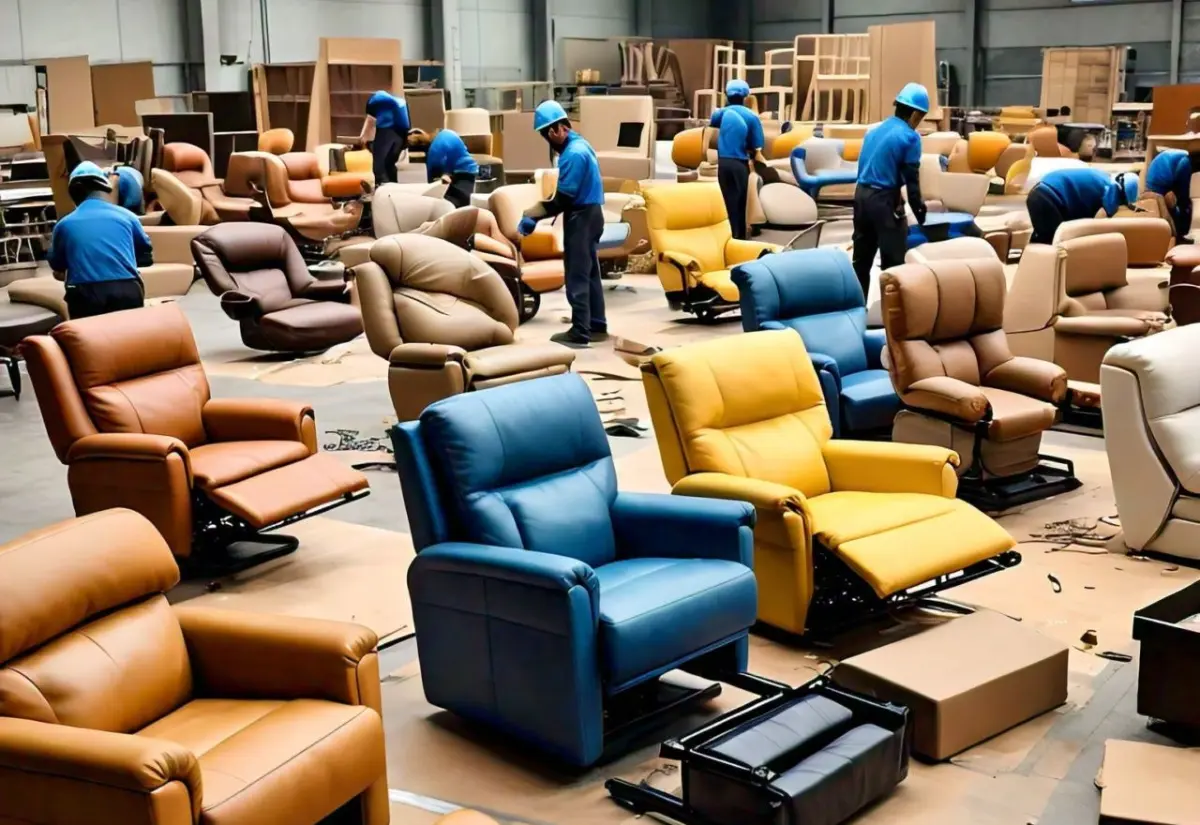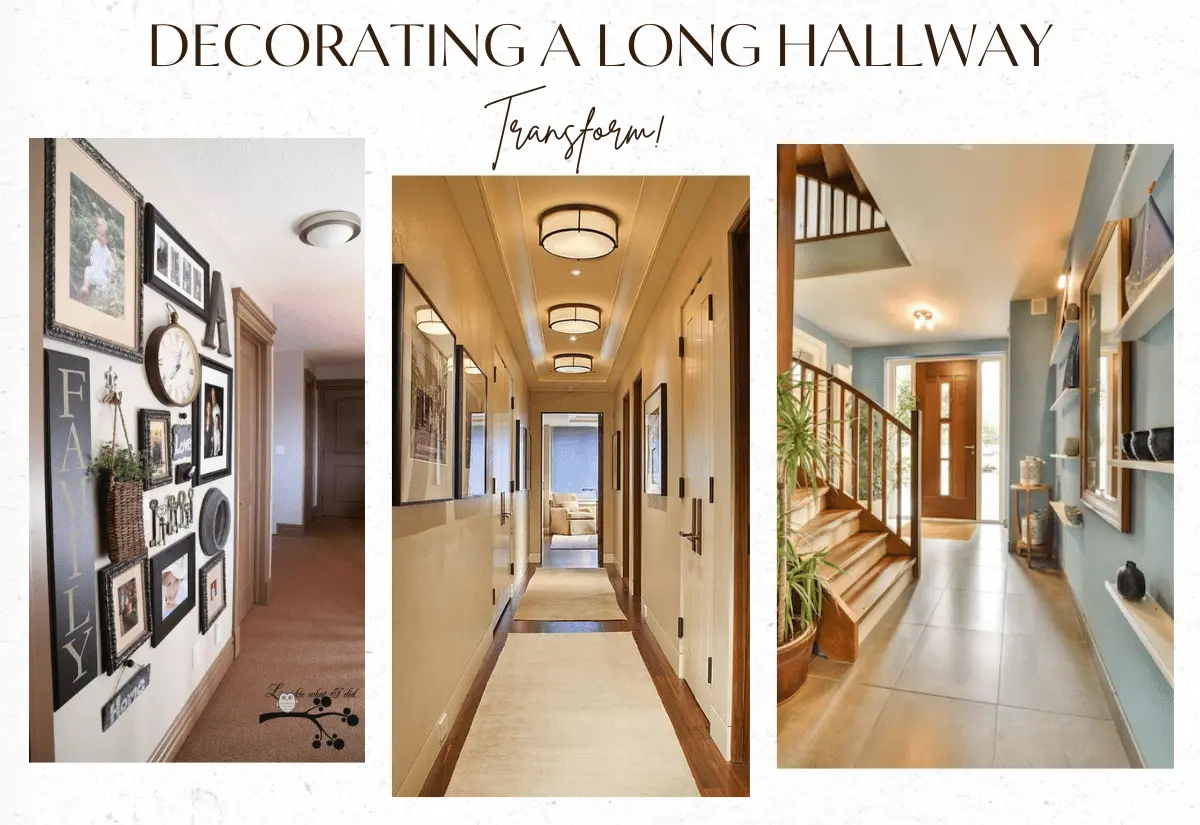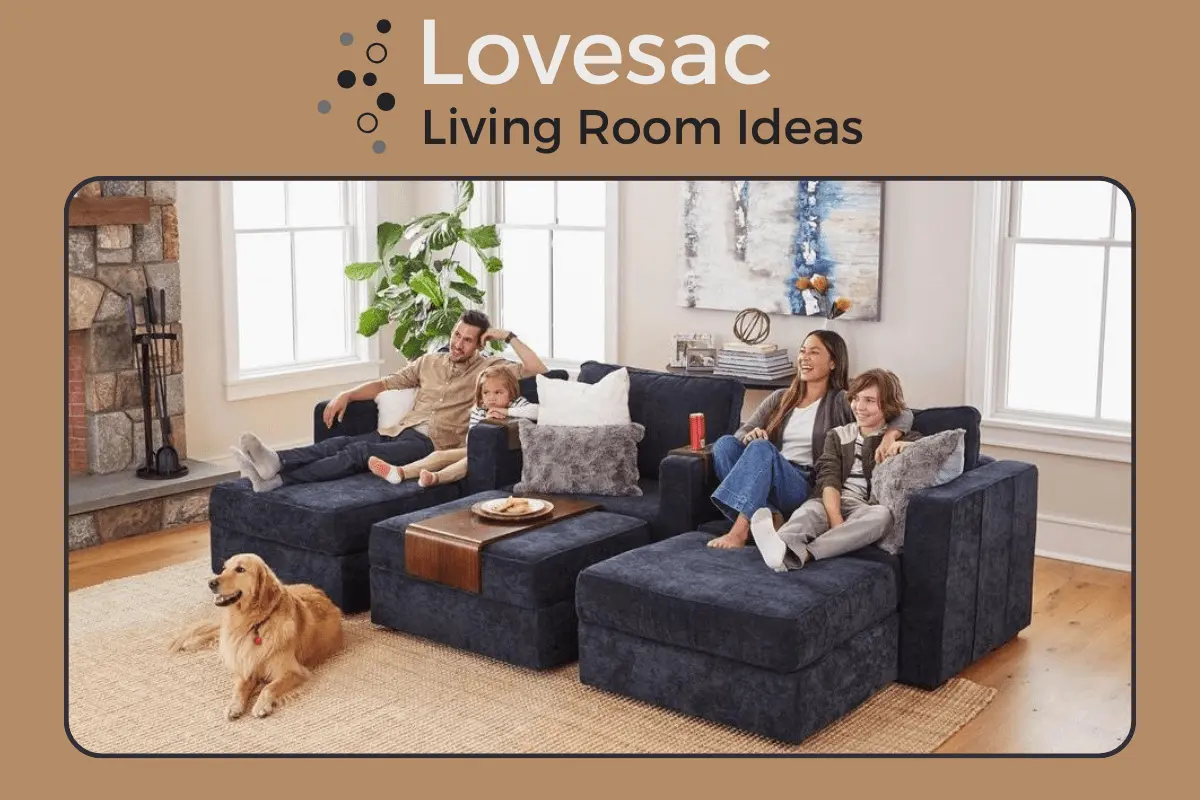Introduction
Large wall art is any artwork that takes up a significant portion of a wall. It can include paintings, photographs, murals, tapestries, or sculptures. This kind of art is not just about decoration; it creates a focal point in a room, adds personality, and can transform any space.
Benefits of Using Large Wall Art in Interior Design
Large wall art can make a room feel complete. It draws the eye and can make a small room feel larger or a large room feel cozier. It allows you to express your style and can be a conversation starter. Whether it’s a bold painting or a serene landscape, large wall art adds depth and character to any room.
Choosing the Right Large Wall Art
1. Understanding Your Space
Measuring Wall Space
Before you choose a piece of large wall art, measure your wall space. This helps you understand what size art will fit best. A good rule of thumb is to leave some empty space around the art so it doesn’t feel crowded.
Considering Room Function and Ambiance
Think about the room where you will place the art. A bright, colorful piece might work well in a living room but feel out of place in a bedroom where you want a calm atmosphere. Match the art to the room’s function and the feeling you want to create.
2. Selecting Art Styles
Abstract Art
Abstract art is perfect if you want to add color and interest without sticking to specific subjects. It can be bold or subtle, and it always makes a statement.
Photography
Photography can capture stunning landscapes, cityscapes, or portraits. It brings real-life elements into your space and can evoke strong emotions.
Minimalist Pieces
Minimalist art focuses on simplicity and clean lines. It’s great for modern spaces and helps create a clutter-free look.
Bohemian Macramé
Bohemian macramé adds a handmade, cozy touch to your space. It’s perfect for a boho-chic style and adds texture to your walls.
3. Color Schemes and Themes
Harmonizing with Existing Decor
When choosing large wall art, consider the colors already in your room. You want the art to complement, not clash with, your existing decor. Pick a piece that has colors that tie the room together.
Seasonal and Rotational Themes
If you like to change your decor with the seasons, consider having different pieces of large wall art for different times of the year. Bright, vibrant art for summer, and warm, cozy pieces for winter can keep your space feeling fresh and updated.
Large wall art can be a stunning addition to any home. By understanding your space, selecting the right style, and harmonizing with your existing decor, you can find the perfect piece to enhance your room’s look and feel.
Types of Large Wall Art
1. Canvas Prints and Paintings
Benefits of Canvas Art
Canvas art is a popular choice for many reasons. It’s durable and has a classic look that suits many styles. Canvas prints can showcase vibrant colors and intricate details. They are also easy to hang and can be moved or rearranged without much hassle.
Popular Themes and Artists
Popular themes for canvas art include landscapes, abstract designs, and portraits. Renowned artists like Vincent van Gogh, Claude Monet, and contemporary artists offer a wide range of styles to choose from. Whether you prefer the tranquility of a seascape or the boldness of abstract art, there’s a canvas print that can enhance your space.
2. Gallery Walls
How to Create a Gallery Wall
Creating a gallery wall involves arranging multiple pieces of art together on one wall. Start by planning your layout on the floor. Use pieces of different sizes and shapes to create visual interest. Once you have a layout you like, hang each piece, starting from the center and working outwards.
Mixing and Matching Frames and Art Pieces
Mixing and matching frames adds depth to your gallery wall. Use frames of different colors, materials, and sizes. Combine different types of art, such as photographs, paintings, and prints, to create a diverse and engaging display.
3. Murals and Wallpapers
Custom Painted Murals
Custom painted murals can transform an entire wall into a work of art. Whether you hire a professional artist or do it yourself, murals can depict anything from a serene landscape to a bustling cityscape. They are unique and can be tailored to fit your personal style and space perfectly.
Peel and Stick Wallpapers
Peel and stick wallpapers are a convenient way to add art to your walls. They come in various designs and are easy to apply and remove. This option is great for renters or anyone who likes to change their decor frequently. You can find patterns ranging from floral to geometric, making it easy to find one that suits your taste.
4. Textural and Fiber Art
Tapestries and Macramé
Tapestries and macramé bring a soft, textural element to your walls. Tapestries can add color and pattern, while macramé offers a handcrafted, bohemian feel. These pieces are great for adding warmth and texture to a room.
Fabric Panels and Quilts
Fabric panels and quilts are another form of textural art. They can be custom-made to match your decor and provide a cozy, inviting atmosphere. These pieces are perfect for bedrooms or living rooms where comfort is key.
5. Sculptural and 3D Art
Metal and Wood Sculptures
Metal and wood sculptures add a three-dimensional aspect to your walls. These pieces can be anything from abstract shapes to detailed figures. They bring a unique element to your decor and can be a striking focal point.
Mixed Media Pieces
Mixed media art combines different materials like metal, wood, fabric, and paint. These pieces can be highly creative and unique, offering a blend of textures and colors that make a bold statement. They are perfect for adding an eclectic, artistic touch to your home.
Installation Tips
1. Planning and Layout
Using Painter’s Tape for Layout
Before you start hammering nails into the wall, use painter’s tape to outline where you want to place your art. This allows you to visualize the arrangement and make adjustments without any damage. Tape the dimensions of each piece directly onto the wall, and step back to see how they fit together.
Ensuring Proper Spacing and Balance
Proper spacing and balance are key to a cohesive look. Leave enough space between pieces to prevent a cluttered appearance. Generally, 2-3 inches of space between each piece works well. Aim to have the center of your art at eye level, which is about 57-60 inches from the floor. This creates a balanced and harmonious display.
2. Tools and Techniques
Essential Hanging Tools
Gather the right tools before you begin. You will need a hammer, nails or screws, a level, a measuring tape, and wall anchors for heavier pieces. Picture hanging kits often include everything you need.
Techniques for Heavy and Large Pieces
For heavy and large pieces, use wall anchors or brackets to ensure they are securely fastened. If you’re hanging on drywall, make sure to use anchors that can support the weight. Stud finders can help you locate the studs in your wall, providing a more secure spot to hang heavy items.
3. Safety and Stability
Securing Art on Various Wall Types
Different wall types require different hanging methods. For drywall, use appropriate anchors. For brick or concrete walls, you will need masonry nails or a drill with masonry bits. Wooden walls are the easiest, as you can screw directly into the wood. Always ensure that the hardware you use is suitable for the weight and type of wall.
Child and Pet-Proofing Tips
To make sure your art is safe for homes with children and pets, secure the bottom corners with adhesive strips to prevent them from being pulled off. Avoid placing heavy or sharp pieces in areas where they might be knocked over. Consider using museum putty for smaller items to keep them steady.
Enhancing Large Wall Art with Lighting
1. Types of Lighting
Spotlights and Track Lighting
Spotlights and track lighting are excellent for highlighting your large wall art. Spotlights can be adjusted to shine directly on your artwork, enhancing its colors and details. Track lighting allows for multiple lights to be directed at various pieces, offering flexibility in illumination.
Wall Sconces and Ambient Lighting
Wall sconces provide a softer, more diffused light that can enhance the overall ambiance of the room. Ambient lighting, such as floor lamps or ceiling fixtures, can also help to create a warm and inviting atmosphere around your art.
2. Placement and Effect
Highlighting Features
To highlight specific features of your artwork, place lights above or below the piece. This technique can bring out textures and details, making your art stand out. Consider using adjustable lights so you can change the focus as needed.
Creating Mood and Depth
Lighting can also be used to create mood and depth. Warm lights can make a space feel cozy and inviting, while cool lights can create a modern, crisp look. Use dimmers to adjust the intensity of the light, allowing you to change the atmosphere of the room depending on the time of day or occasion.
Trends and Inspiration
1. Current Trends in Large Wall Art
Popular Styles and Materials
In today’s home decor, large wall art trends are constantly evolving. Some popular styles include:
- Abstract Art: Bold, colorful, and expressive, abstract art continues to be a favorite for its ability to bring life and energy to a space.
- Minimalist Art: Clean lines and simple designs in neutral colors are perfect for those who prefer a more understated look.
- Nature-Inspired Art: Pieces that depict landscapes, botanical prints, and wildlife are increasingly popular as they bring a touch of the outdoors inside.
- Mixed Media: Combining different materials like metal, wood, and fabric to create unique, textural pieces.
Influential Artists and Designers
Artists and designers who are making a mark in the world of large wall art include:
- Banksy: Known for his provocative street art, Banksy’s pieces often carry strong social messages.
- Yayoi Kusama: Her use of polka dots and vibrant colors create mesmerizing, large-scale installations.
- Danielle Clough: This South African artist uses embroidery to create stunning, intricate wall art that stands out for its originality.
2. Inspiration from Different Cultures
Global Art Influences
Different cultures offer a wealth of inspiration for large wall art:
- African Art: Known for its bold patterns and rich colors, African art can add vibrancy and a sense of history to your space.
- Asian Art: Minimalist yet deeply symbolic, Asian art often incorporates elements of nature, such as cherry blossoms or koi fish, to create serene and balanced pieces.
- Latin American Art: With its vivid colors and dynamic patterns, Latin American art brings energy and passion into any room.
Incorporating Cultural Artifacts
Incorporating cultural artifacts into your wall art can add depth and meaning to your decor. Consider using:
- Tribal Masks: These can add a dramatic and authentic touch to your walls.
- Textiles: Hang traditional textiles, such as Indian saris or Mexican serapes, to bring in texture and cultural significance.
- Ceramics and Pottery: Displaying ceramics from different cultures can add a three-dimensional aspect to your wall decor.
Affordable Options for Large Wall Art
1. DIY Projects
Creating Your Own Art
One of the most rewarding ways to decorate your space is by creating your own art. Here are some ideas:
- Abstract Painting: Use large canvases and acrylic paints to create your own abstract masterpiece. Experiment with colors and shapes.
- Photo Collage: Print your favorite photos and arrange them into a large collage. This can be a personal and meaningful addition to your home.
- Stencil Art: Use stencils to create patterns or images on canvases or directly on the wall.
Budget-Friendly Materials and Tools
Creating your own art doesn’t have to be expensive. Here are some budget-friendly materials and tools:
- Canvases: Buy them in bulk to save money.
- Acrylic Paints: These are versatile and affordable.
- Stencils and Spray Paint: Great for creating patterns quickly and easily.
- Recycled Materials: Use old magazines, fabric scraps, or even cardboard to create unique pieces.
2. Affordable Art Sources
Online Marketplaces
There are several online platforms where you can find affordable large wall art:
- Etsy: A great place to find original art from independent artists.
- Society6: Offers a wide range of prints, often at very reasonable prices.
- Redbubble: Features art from artists around the world, available on various mediums.
Local Artists and Art Fairs
Supporting local artists is a wonderful way to find unique and affordable pieces:
- Art Fairs: Visit local art fairs to find one-of-a-kind pieces and negotiate directly with artists.
- Local Galleries: Check out local galleries for emerging artists who may offer their work at lower prices.
- Community Art Shows: These can be excellent opportunities to find hidden gems.
Conclusion
Large wall art is a powerful tool in interior design, capable of transforming any space with its presence. By understanding current trends, drawing inspiration from different cultures, and exploring affordable options, you can find or create the perfect pieces to enhance your home. Whether you opt for popular styles or unique DIY projects, large wall art offers endless possibilities to express your personal style and make your space truly your own.
FAQs
Q1: How do I choose the right large wall art for my living room?
Consider the size of your wall and the overall style of your living room. Measure the wall space to ensure the art will fit well and choose a piece that complements your existing decor and color scheme. Think about the mood you want to create—bold and vibrant or calm and serene.
Q2: Can large wall art make my living room look bigger?
Yes, large wall art can create the illusion of a larger space by drawing the eye upward and outward. Choosing pieces with light colors and minimalist designs can enhance this effect.
Q3: What is considered extra large wall art?
Extra large wall art typically refers to pieces that are over 60 inches in one dimension. These pieces are designed to make a significant impact and often serve as the focal point of a room.
Q4: How should I hang extra large wall art securely?
Use heavy-duty wall anchors or brackets, especially if you’re hanging on drywall. Make sure to secure the piece to studs in the wall for added stability. Always check the weight limits of your hanging hardware.
Q5: What are the benefits of large wall art prints?
Large wall art prints are often more affordable than original artwork and come in a wide variety of styles and subjects. They can be easily replaced or updated to match changing decor trends.
Q: Where can I buy high-quality large wall art prints?
A: Online marketplaces like Etsy, Society6, and Redbubble offer a vast selection of high-quality prints. Local art stores and galleries may also have prints from local artists.
Q6: How can I find inexpensive large wall art?
Look for sales on online marketplaces, visit thrift stores, and check out local art fairs. Creating your own art through DIY projects is another cost-effective option.
Q7: Are there affordable options that still look high-end?
Yes, canvas prints and framed posters can look high-end if you choose pieces with stylish designs and high-quality printing. Shopping during sales and choosing timeless pieces can also help maintain a sophisticated look on a budget.
Q8: What are the advantages of large canvas wall art?
Canvas wall art is durable, lightweight, and easy to hang. It offers a textured, professional look and can come in various styles and sizes to suit any living room.
Q9: How do I care for large canvas wall art?
Dust the canvas regularly with a soft, dry cloth. Avoid direct sunlight to prevent fading, and keep it away from humid areas to prevent warping or mold growth.
Q10: What are the benefits of horizontal large wall art?
Horizontal large wall art can make a room feel wider and more spacious. It’s perfect for over sofas, beds, or long hallways and can help create a cohesive look by stretching across a significant portion of the wall.
Q11: How should I position horizontal wall art?
Place horizontal art at eye level, about 57-60 inches from the floor to the center of the piece. Ensure there’s enough space on either side to avoid a crowded look and align it with furniture for a balanced appearance.




